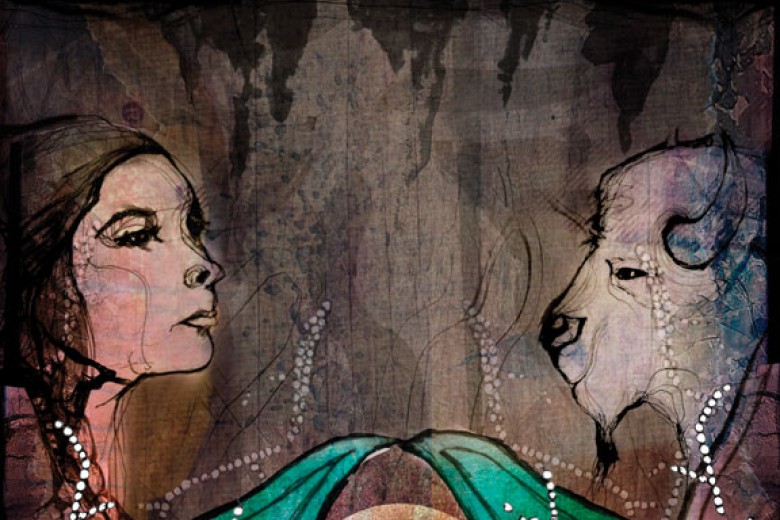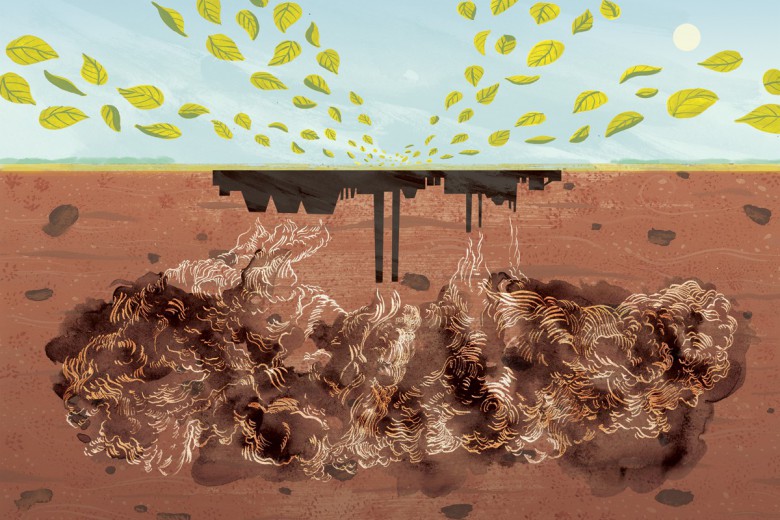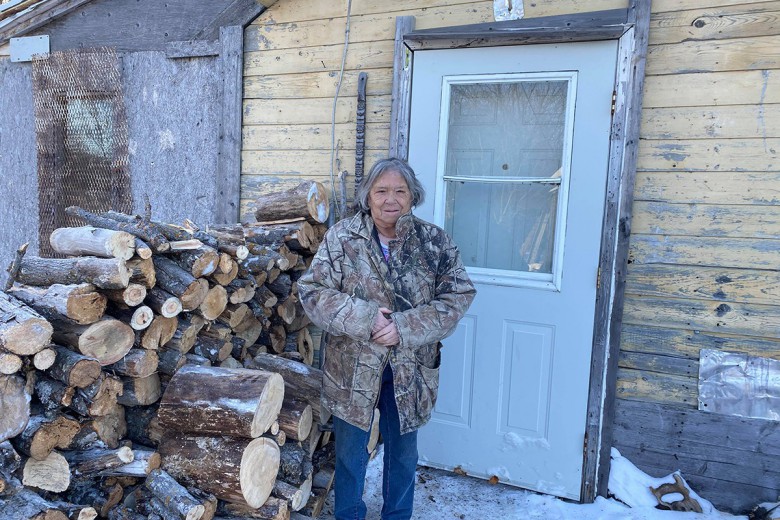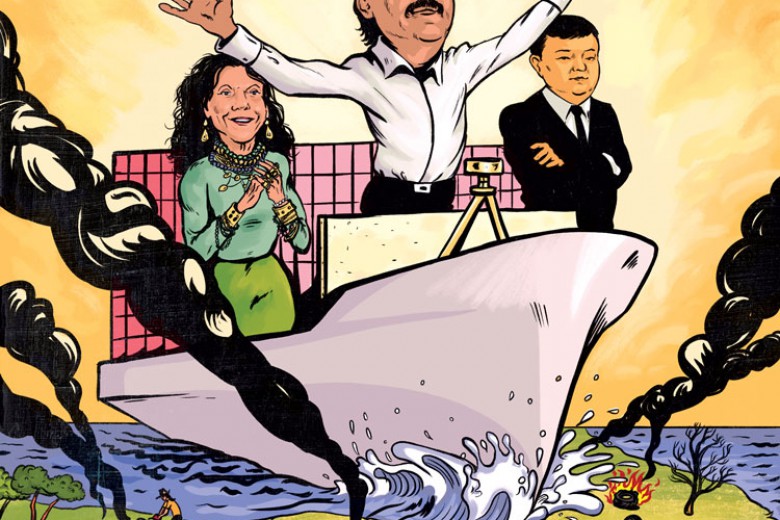A vintage coffee mug cradled by a disembodied white hand. A pair of rustic boots propped up next to a crackling beach fire. A wooden shelf of squat succulents languishing in Mason jars. A handmade Mexican blanket strewn over a driftwood log. All photos posted on the photo-sharing site Instagram, all of them marked #liveauthentic.
The sparse, wholesome #liveauthentic aesthetic is dominating commodity culture in fashion and design. Ironically, though, the hashtag renders the images in its feed indistinguishable from one another. Our search for the “real thing” has led to an aesthetic assembly line that spits out interchangeable items of privilege.
The call to #liveauthentic yields to nostalgia, exclusion, and colonial erasure, and the marketplace is cashing in.
Nature and nationalism
Many of the photos marked #liveauthentic depict a solitary human basking in the glow of pristine nature. The mountains, streams, and sunsets are unmarred by power lines, cabins or, God forbid, other people – thus perpetuating what Sheelah McLean describes as “white-settler fantasies of the Canadian landscape as empty and wild.”
North America’s colonial-capitalist history has long been contingent on marketing the beauty of the natural world, spinning a narrative of a landscape that was, in the spirit of terra nullius, available to be “tamed” and exploited by settlement and industry. Bryce Henson observes that this ongoing colonial erasure relies upon using the “pre-Columbus past as a mechanism to produce an essentialist notion of Indigenous peoples, who majestically vanish upon contact into the contemporary moment.”
Nationhood has been and is reinforced by a myth that emerged alongside the actual history of dispossession and racialized violence that was used to validate settlement. Aman Sium defines the “visionary project of building and maintaining a settler state” as a two-fold process: “there are the immediate projects of clearing ‘virgin’ land for industry and settlement,” he writes, as well as the construction of a “racial category of enslavable and otherwise indentured labor to help cultivate it.” What results is a conceptualization of Indigenous peoples as “always dead, dying or inexplicably disappeared” from our current nostalgic representations of nature, except for their symbolic traces.
The #liveauthentic aesthetic is part of a larger narrative of commodification, born of imperialism and nurtured by Euro-American philosophies. Rapid growth in both industrialization and consumer culture at the end of the 19th century, followed by the First World War, brought about modernist commodity culture. It was marked by a fascination with new technologies like radio, film, electricity and the combustion engine, as well as architectural innovations like skyscrapers and department stores. The end of the Vietnam War in 1975 prompted the shift of North American commodity culture into the postmodern era, which cast skepticism on reality, resulting in the artistic use of irony to question previously accepted structures of power and control. The distinction between “low” and “high” art was challenged, spurring a new appreciation for practices like street art and DJ culture. Some historians have identified 9/11 as the end of postmodernism, saying it was an event that, in combination with the rise of the Internet, social media, and surveillance technologies, ushered in a new understanding of histories, identities, politics, and nature.
Alan Kirby uses the term “pseudo-modernism” to describe our current state, which he defines as “consumerist and conformist, a matter of moving around the world as it is given or sold.”
Texting, gaming, photo-sharing, tweeting, online shopping, working, flirting: this hyperactive engagement with the world through various screens and media has prompted many to pine for the reassuring stability offered by ahistorical fantasies of the past, via commodities that convey associations with simpler times.
Authenticity as commodity
In “Postmodernism is Dead,” Edward Docx identifies a “growing desire for authenticity” among today’s consumers. In response, brands “are trying to hold on to, or take up, an interest in ethics,” and in our “growing reverence and appreciation” for “hand-crafted” goods. Think artisanal pottery, hand-embroidered linen napkins, the resurgence and popularity of haberdashers, cobblers, microbrewers, and beekeepers – operations geared toward both utilitarian and ornamental domestic use, and marketed as a relief from products like computers, video games, televisions, and cars. The Luddite rejection of new media and technology in favour of handmade goods is in this sense motivated not by ethics but by aesthetics. It is not a protest of capitalism, per se; after all, consumers wilfully play their part, provided the commodities don’t look like commodities.
What Docx alludes to is something akin to the DIY hipster trends made popular by stores such as Anthropologie and Urban Outfitters, whose combined revenue in 2015 topped US$1 billion, and publications like Kinfolk, a $21 magazine devoted to “small gatherings” and slow living. Jay Horton notes Kinfolk’s privileging of the visual over the textual, observing the “typos … scattered about shrunken packets of prose” and a “quantity of white space inversely proportional to the number of photographs depicting people of color.” The customer base of these publications and commercial chains are primarily upper-class, young, white, cisgender people with disposable incomes. The activities that Kinfolk promotes – harvesting, canoeing, canning, and eating and sleeping outdoors – also map onto traditional knowledge systems and ways of life for many communities, but they have been subsumed into a popular lifestyle marketed as viable only for those who have the time and money to perform them recreationally.
Kinfolk’s popularity is due in large part to the power and malleability of images in today’s trend-making. Historical visual representations can easily be appropriated; images are susceptible to surface interpretation and fetishization. Furthermore, snapshots act as proof (of experience, belonging, good taste) in a way that writing cannot. This may be the reason why Instagram has become such an ideal platform for self-expression, encouraging its users to apply filters and effects to their photos to better reflect their individuality. Somehow, though, verisimilitude (reinforced by hashtags like #nofilter) is still the driving force behind the visual medium. Perhaps we can call this image-driven, uniquely post-postmodern cultural movement the “New Authentic.”
Hashtag cultural capital
A project that garnered attention (and over a million followers) for its cutting satire of formulaic replicability was the short-lived Socality Barbie feed on Instagram. The account featured the paragon of materialism, homogeneity, and privilege – Barbie – crafting, drinking espresso, hiking, and posing in woodsy settings. The satire hinges on our familiarity with the New Authentic. Hashtags like #wildernessculture, #neverstopexploring, #livefolk, #visualcoop, and #peoplescreatives remediate previously anti-capitalist categories into a discourse of capitalism that bleaches such initiatives of their political power. For example, whereas co-operatives offer a political alternative to monopoly, their invocation in this new context reinforces a lifestyle perpetuated by consumer production and consumption through a manufactured sense of community. Community, like authenticity, has gained cultural capital with the rise of image-based social-media platforms. How does this community get built? If two Instagram users employ the same hashtag – say, #peoplescreatives – they will not only be grouped together visually within a grid of photos but also become linked in a virtual community that hinges on tastes or aesthetics, regardless of their political, ethical, or philosophical differences.
Nostalgic for the good ol’ days
The impulse to escape the city and retreat to the wilderness is not a new phenomenon, but it has intensified in recent years. Renewed interest in writers like Thoreau and Emerson, as well as in artisanal crafts – such as woodworking and weaving, and homesteading activities like bread baking, organic farming, and canning – demonstrate nostalgia for a way of life tied to the natural world.
According to John J. Su, since the 20th century, nostalgia has been “characterized as a form of amnesia,” in that it projects a fantasy backward, pasting a rosy view of the past over top of difficult realities. To be sure, the idea of a “pure” nature is more a fantasy now than ever before, due to widespread environmental devastation brought about by urban sprawl, pollution, and the impending exhaustion of key natural resources. The sublime mountain ranges and picture-perfect lakes in the images perpetuated by the New Authentic demonstrate that the participants are not only oblivious to their utopian projections, they don’t pretend to participate in any kind of environmental activism or solidarity with communities of resistance. Su writes that nostalgia “signifies inauthentic or commodified experiences inculcated by capitalist or nationalist interests.” Nostalgia has been co-opted through highly marketed products like birchbark aftershave, Herschel Supply backpacks or the yurt as a weekend getaway, for example – all of which promise a return to simpler times: the quiet of the woods, the stillness of the lake, the pure air. These very items are sold on the premise that they offer an escape from the frenetic cycle of capital, thus robbing them of any political power.
Although what Socality Barbie satirizes, with her references to the Pacific northwest and her liberal use of the Stars and Stripes as backdrop, is a particularly American trend, white Canadian hipster sensibilities are also implicated in the fad. The popularity of the Hudson’s Bay blanket associated with the New Authentic is an especially effective example of the fetishization of nature and amnesiac nostalgia. In recent years, Hudson’s Bay has refocused its branding to emphasize the point blanket as a symbol of Canadian blue-collar culture and inclusivity, a myth that is itself underpinned by a narrative of colonial erasure in light of the Hudson’s Bay Company’s role in imperial capitalist relations with Indigenous communities.
Such is the confluence of commodity and visual culture in the New Authentic: the Hudson’s Bay blanket is but one symbol of national identity that is complicit in rewriting Canada’s colonial and class history. As McLean notes, Canada’s “history of colonial violence must be silenced in order to maintain a national identity of innocence,” thereby allowing “white settlers to imagine that they participate in a post-racial culture.” Our dedication to such an aesthetic is our own participation in the re-construction of histories and images for the sake and proliferation of capitalism.
How authentic is that?







